We cannot deny that social media plays a huge role in our lives more so during this pandemic. In the absence of face-to-face interaction, Facebook, Instagram, Twitter provide safe and convenient ways for us to connect with family, friends and even work colleagues. Social media updates us on the events in each other’s lives without having to initiate contact and ask “How are you?” Such information is freely shared and available through a mere tap of a finger.
But too much of a good thing may lead to problems. Though virtual interaction may be beneficial to our mental health during the pandemic, mindless scrolling of social media feeds can lead to sadness, loneliness and even exhaustion. Because mobility and activities are currently limited, such emotions may push us to simply pick up the smartphone and indulge in another round of scrolling. To better care for our mental health, we need to break this cycle.
What is social media detoxification?
According to Itin Lachica-Umali, a Psychology professor at the Colegio De San Lorenzo, social media detox is a component of digital media detox. This involves refraining from or minimizing the use of television, and other “technology vices” in favor of face-to-face connection.
Though social media is convenient, the constant distraction it offers may keep us from processing our own experiences. Because the pandemic is unforeseen, Psychologist Roselle Teodosio, owner of IntegraVita Wellness Center, believes that we must be allowed to grieve. “There is an added pressure, most especially from social media, to make the most out of the situation, kind of like making lemonade out of lemons. This can make people more frustrated with themselves, when they can’t seem to find their own “niche.” Also, people are afraid to show their fear, lest they be labeled as negative or a pessimist. But it is actually okay to feel not okay, to admit that one feels fear, that one is afraid, that one cannot function well since there is really an uncertainty during this time. It is also very natural to grieve. Grief would mean an end to something, not just death of a person. It is an end to a friendship, an end to a relationship, an end to a dream and most of all, an end to a lifestyle, a life one had known.”
Umali agrees that social media may push you to compare yourself with others. “This is the root of unhappiness,” she says. “We need to detoxify from social media so we can pause and process things in our own time.”

When do you need a social media detox?
If you experience any of the of the following, you may need to take a break from your computer or phone:
- Spending most of your waking hours on the internet. Experts recommend a maximum of 30 minutes spent on social media daily. According to a 2018 study published in the Journal of Social and Clinical Psychology, this can lead to better health outcomes.
- Not being able to connect face-to-face. The internet should enhance our lives, and not take the place of our reality. If you text or chat in the virtual realm more often than communicating with the family members you live with, then it’s time to disconnect for a while. Real-life interaction boosts your social skills and mental health.
- Not being able to function without social media. Umali shares, “When the person acts as if the phone is an extension of his hands, and he brings it wherever he goes—that is already too much of usage. We are all at risk for social media addiction. Social media should bring out the better versions of ourselves, not our lesser versions.”
Here are some steps for social media detox:
- Have a detox buddy.
- Delete social media apps on your phone.
- Plan new morning and bedtime routines that do not involve your phone.
- Use technology only for reasons other than scrolling through social media.
- Spend more time observing the world around you.
- Converse more with the people in your household.
When you do a social media detox, you may observe these benefits:
- Self-esteem improvement. With more time in your hands, you will be able to process your emotions and experiences more effectively. As a result, you can better gauge the steps you need to take to improve your life. “There’s clarity because you got rid of the stimuli. You are able to think properly, and instead of being just reactionary, you can be proactive,” says Umali.
- Reduced anxiety. “Because of the many things you hear in social media, especially about the pandemic, you tend to get more anxious,” warns Umali. “Should you get vaccinated or not? Even the video of the ladies who took all the eggs from the community pantry became viral, and were bashed. This produced anxiety on their part, so we also need to control our actions so they won’t affect the mental health of others.”
- Increased interaction with the people around you. Though real-life interaction with people outside our household is not recommended during this time, Umali advises to communicate regularly with those around you. “Face-to-face interaction is still better than virtual interaction.”
- Being grateful for what you have. Disconnecting from social media keeps you from comparing yourself with others. It also abates the fear of missing out. Appreciate your blessings and cultivate a positive mindset.
According to Umali, the responsible use of social media begins with thinking before clicking. Carefully think about your comment before posting it. Will it harm other people? What does it say about you as a person? Whatever you put on social media reflects your values and beliefs. Be a responsible user—and this includes limiting your time on social media in order to be healthier.
Weather forecasts are essential today as they were centuries ago. Our ancestors used observation methods to predict the weather, such as the loud croaking of frogs and the animals’ frantic scramble for shelter, believed to indicate imminent rain or stormy weather. Rain may also be preceded by a red sunrise, cloud towers on mountains, and a starless sky. The sound and sight of giant waves rolling are signs of a looming storm.
Meanwhile, the change of seasons is seen through the ripening of certain fruits. The proliferation of duhat, kaimito, langka and melon happens during the dry season, while the abundance of durian, guyabano, santol and siniguelas signifies the wet season. These observations are especially useful to farmers, sailors, and fishermen whose livelihoods are weather-based.
Fast forward to modern times, and weather forecasts are now available across all media platforms. Despite their accessibility, many are not aware of how much work is involved in coming up with reliable forecasts. According to PAGASA Weather Forecaster Aldczar Aurelio, the process requires several steps and the use of weather instruments. “We analyze weather maps (current and previous data), interpret the weather data coming from synoptic stations, monitor the images from weather satellites, analyze the outputs of numerical meteorological weather prediction, and discuss with fellow weather forecasters. It’s also important to know weather patterns or the behavior of weather systems for particular months or seasons.”

The Importance of Weather Forecasts
Because of our country’s geographical location, the Philippines is prone to natural disasters including tropical cyclones. According to PAGASA, about 20 tropical cyclones enter the Philippine Area of Responsibility, bringing with them hazards such as floods and destruction.
In October last year, Typhoon Ulysses entered the country during the pandemic, causing 67 deaths and more than P16 billion damage in agriculture and infrastructure. Though typhoons cannot be prevented, impacts can be mitigated through preparedness. According to Aurelio, weather forecasts can help in the following:
- Protecting life and property
- Helping people to dress accordingly and prepare weather essentials such as raincoats, umbrellas and sunscreen
- Serving as guides in power production and consumption. Energy production relies on weather elements such as wind speed, air pressure and air temperature.
- Helping people plan their activities
- Aiding businesses plan for transportation hazards such as thunderstorms, rains, and strong winds
- Helping people prepare for weather-related health issues such as allergies, asthma, and heat stress
- Helping communities plan for severe weather and weather hazards such as lightning, hail, flooding, and landslides
- Guiding the agricultural sector in planning for crop irrigation and protection
- Providing weather information for the tourism industry
 PAGASA Weather Specialist Aldczar Aurelio
PAGASA Weather Specialist Aldczar Aurelio
Observing Weather on Your Own
Should you find yourself in a situation that hinders you from receiving weather forecasts, Aurelio suggests that observing your surroundings like what our ancestors did.

Cloud formations
Aurelio states that cloud observation is a basic foundation of meteorology. “There are three types of cloud formations. High clouds, middle clouds and low clouds,” he shares. “High clouds are associated with good weather— sunny, clear and fair. It’s ideal for outdoor activities. Middle clouds are associated with fair weather, but also with the brewing of bad weather. Low clouds are associated with bad weather—storms and rain. Cumulonimbus known as thunderstorm clouds are examples of low clouds. These low clouds are common during the rainy season.”
He also added some folk knowledge in predicting the weather, “When you see tower-like clouds, expect rain because those will bring thunderstorms. If you see a field [of clouds] on the base of clouds, it’s possible to experience a tornado.”

Stars
As to the popular belief that starless skies predict rain, Aurelio says that “Clouds that can cause severe thunderstorms cover the whole sky dome. “ But if a few stars are visible, then rain is still possible.
Given the ever-changing weather systems, forecasts are never 100% accurate. But the constant monitoring of weather forecasts and a keen awareness of our surroundings may boost our safety and preparedness. After all, we cannot escape the seasonal changes of our country’s weather even during a pandemic.
Though the country’s first COVID-19 case was reported over a year ago in January, the last time Valentine’s Day was observed is drastically different from this year’s celebration. In 2020, couples memorialized their love through dinner dates, out-of-town trips and watching movies. But with COVID-19 still at large, movement is restricted with establishments forced to limit their number of guests to maintain physical distancing.
To find out how lovers will celebrate this day of hearts, Panahon TV interviewed three couples.
 Charlotte Ramirez and Jan Gianan
Charlotte Ramirez and Jan Gianan
Young Love
Jan, 29, and Charlotte, 30, met in their previous job as call center agents. Both Singles for Christ members, the couple plans to celebrate their 4th year of togetherness with their usual Valentine’s date. “We’ll do the same thing that we did pre-pandemic—hearing mass, eating together, and having a conversation,” says Jan. “Every day is Valentine’s day when you show your love for each other.”
For them, love means supporting each other in their professional paths. While Jan aims to be a full-time teacher, Charlotte is busy as a working student. “There have been many challenges in our relationship but with the grace of God, we’re thankful to be still together,” shares Jan. To secure their future, they began a coffee drip business, which they wish to expand. As soon as Charlotte graduates, the couple plans to get married and start a family.
Because their relationship is anchored in God, Jan believes that love should be constant, able to sustain couples through tough times. “For me, love is unshaken whether there is a pandemic or not,” he says.
 Teofilo Singcol and Marcela Singcol
Teofilo Singcol and Marcela Singcol
Long and Lasting Love
64-year-old Teofilo shares how he met his wife 60-year-old Marcelo during his grandmother’s wake in 1974. “My sister introduced me to her, and we fell into conversation because the color and fabric of her dress perfectly matched my polo shirt’s. That same year, we became a couple.” Exactly a decade later, Teofilo and Marcela got married. “We are aiming for a forever relationship. With the help of God, we try our best to be together until the end.”
This year, the Bohol-based couple plans to spend Valentine’s Day in a beach resort. By strictly following health protocols, Teofilo hopes to make their 35th year of marriage memorable for both of them.
Though it is easy to give into fear in the face of uncertainties during the pandemic, Teofilo believes in replacing fear with love. “In any relationship, both sides should be understanding. They must learn to give and take, and to simply talk things out during both good and bad situations.”
 Jovemar “Bojie” Palorma (left) and Arceli Palorma
Jovemar “Bojie” Palorma (left) and Arceli Palorma
Long-Distance Love
Physical distancing may be a requirement these days, but for Arceli, 33, and Bojie, 35, their long-distance relationship has been keeping them apart even before the pandemic. “My husband is working in Saudi Arabia, and he can’t come home because of the pandemic,” reveals Arceli.
She describes their relationship as simple and practical. “When my husband’s here, we’d go to the movies even when there’s no occasion.” After a 13-year-relationship blessed with four children, Arceli shares their goals as a couple. “We plan to grow old together, see our kids graduate, and stay in love.”
Beyond roses and chocolates, Arceli believes that the greatest gift she and her husband can give to each other is trust. “A long-distance relationship is both a physical and emotional challenge. Trust and having an open mind are important in overcoming difficulties in our relationship.”
Wondering how to celebrate this special occasion? Here are tips to help you spread the love and not the virus this Valentine’s Day:
Sing at home. Serenade each other to your heart’s content in the safety of your own home. No videoke machine? No problem! Search the internet for instrumental versions of your theme songs. Better yet, bust out that old guitar and start serenading the old-fashioned way.
Couple spa. Take turns giving each other a soothing massage to melt away pandemic stress. Light some scented candles and put on some music to put you in a romantic mood.
Share a virtual meal. Couples with long-distance relationships can share a meal virtually. Decide on your common menu, and watch each other eat at the same time to enjoy a semblance of a real date. Meaningful conversation makes the experience even more memorable.
Write a poem. If your partner’s preferred love language is through words, why not express your love through a poem? Your loved one will appreciate your time and effort in completing such a challenging yet heartfelt task. Reading your poem aloud can be your way of renewing your couple vows.
Disconnect. Shut out the chaos of the online world so you can focus on your partner. By getting rid of distractions, you can take time to talk about things that matter. Reminding each other of why you fell in love can be a powerful force in sustaining your relationship.
Now that we are in the middle of a pandemic, give your loved one the gift of health by being healthy yourself. Be responsible for your actions and follow safety measures. Stay healthy; stay in love!
Donna Lina with Agay Llanera
With the whole world racing to beat the pandemic, COVID-19 vaccinations are at the top of the global news pile. According to Bloomberg, the United States tops the list of having the most vaccinations so far at the rate of over 2 million doses per day.
Since the start of the Philippines’ vaccination drive last March 1, the latest tally of total vaccinations is now over 114,000. Besides the delayed arrival of vaccines, another hurdle the country’s mass vaccination faces is the Filipinos’ reduced confidence in vaccines. According to a recent survey, 46% of Filipinos are unwilling to get inoculated against COVID-19 even if the vaccine was proven safe and effective.
A Brief History of Vaccines
English Physician Edward Jenner is widely recognized to have made the first vaccination in 1796. After inoculating a child with smallpox virus, the vaccinee developed an immunity to the disease. Mass immunization following the development of the smallpox vaccine led to the disease’s global extermination in 1979.
The Centers for Disease Control and Prevention (CDC) acknowledges the crucial role of childhood vaccines in preventing the following diseases:
- polio
- measles
- diphtheria
- pertussis (whooping cough)
- rubella (German measles)
- mumps
- tetanus
- rotavirus
- Haemophilus influenzae type b (Hib)
For communicable diseases, vaccines act as extra protection for the body and the entire community. To get this kind of protection, a community must achieve herd immunity.
What is Herd Immunity?
Herd immunity or population immunity is defined by the World Health Organization (WHO) as the “indirect protection from an infectious disease that happens when a population is immune either through vaccination or immunity developed through previous infection.” WHO makes it clear that it supports herd immunity against COVID-19 through vaccination.
This is achieved through mass vaccination, enabling majority of the population to be immune to the disease. Scientists are still researching how much of the population needs to be inoculated for herd immunity against COVID-19 to take place. In the Philippines, the government announced its plans to vaccinate 100% of its adult population or about 70 million Filipinos.
COVID-19 Vaccination Plan in PH
Last February, the Inter-Agency Task Force for the Management of Emerging Infectious Diseases (IATF-EID) finalized the priority list for the COVID-19 vaccination drive.
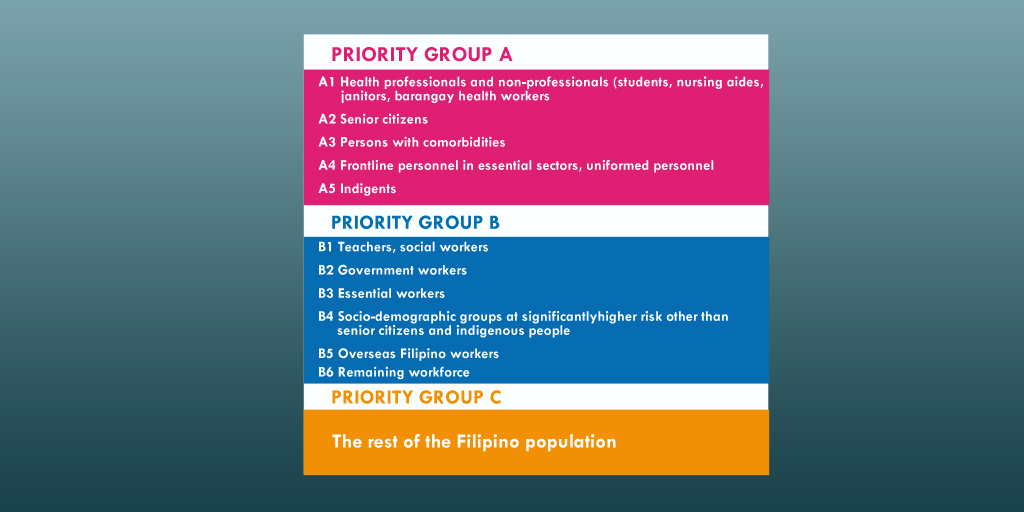 Source: Philippine News Agency (PNA)
Source: Philippine News Agency (PNA)
According to the Philippine National Deployment and Vaccination Plan for COVID-19 Vaccines, the government has accumulated ₱82.5 billion to cover costs of procuring vaccines, logistics, distribution and monitoring.
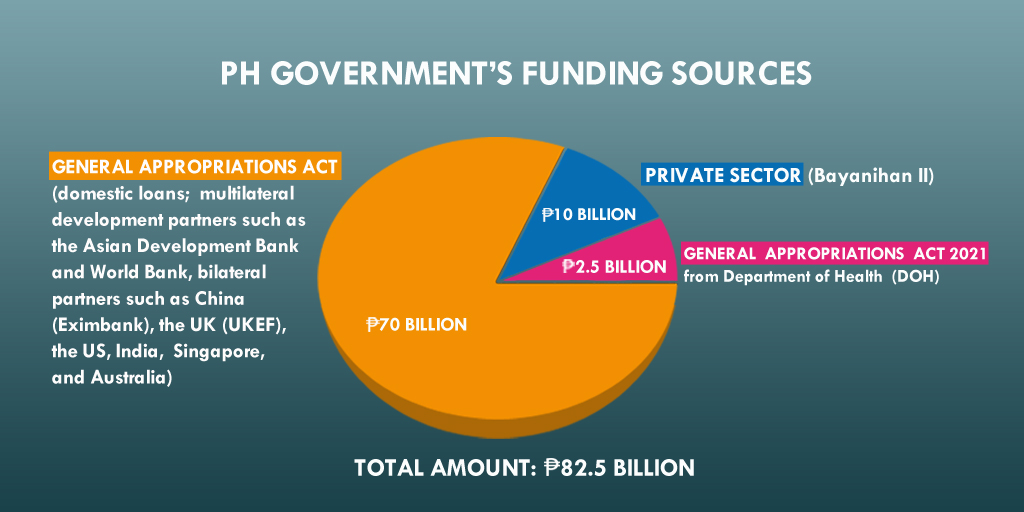 Source: DOH
Source: DOH
With vaccination costs pegged at ₱1,300 per individual according to Department of Finance (DOF) Secretary Carlos Dominguez III, around 57 million Filipinos will benefit from the nearly ₱75-billion funds allocated by the government for vaccine acquisition. The remaining individuals are to be covered by the local government units (LGUs) and the private sector. Under the Bayanihan to Recover as One Act, the national government, local government units (LGUs) and about 300 Philippine companies signed an agreement with British pharmaceutical company AstraZeneca to procure 17 million vaccine doses. In this article, Presidential Adviser for Entrepreneurship Joey Concepcion said that half of the vaccine doses will be given to the national government, while the remaining half are for the companies’ workforce.
Nationwide Vaccination Drive
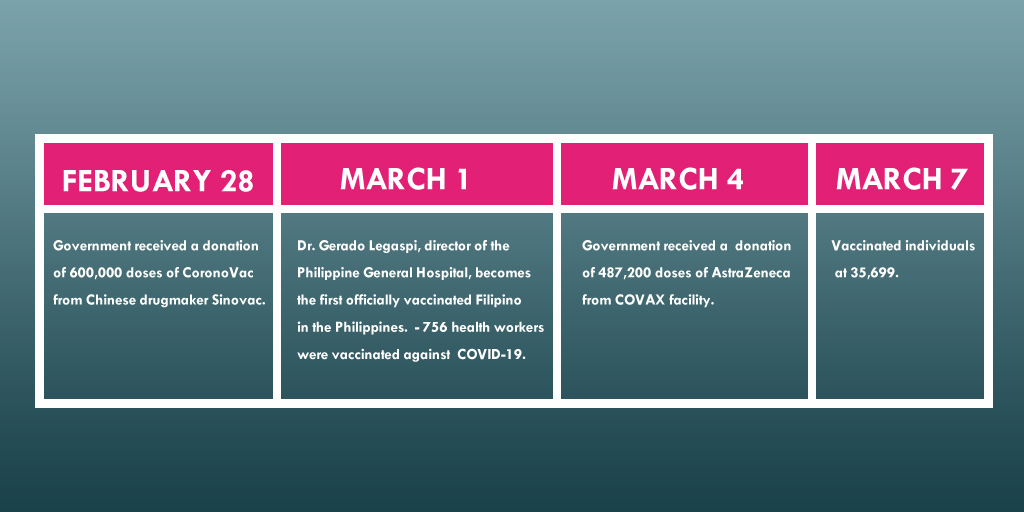 Sources: DOH, WHO, PNA
Sources: DOH, WHO, PNA
 Over 480,000 doses of AstraZeneca vaccine arrive in the Philippines from the COVAX facility. (Photo from National Task Force Against COVID-19)
Over 480,000 doses of AstraZeneca vaccine arrive in the Philippines from the COVAX facility. (Photo from National Task Force Against COVID-19)
With population projections from the Philippine Statistics Authority, the government developed a three-year vaccination plan from 2021 to 2023. The roadmap assumes that by 2022, those 16 years old and below may be allowed to take the vaccine, and that by 2023, newborns can be inoculated against COVID-19. Those who’d taken the shots in 2021 will be given booster shots in the succeeding years.
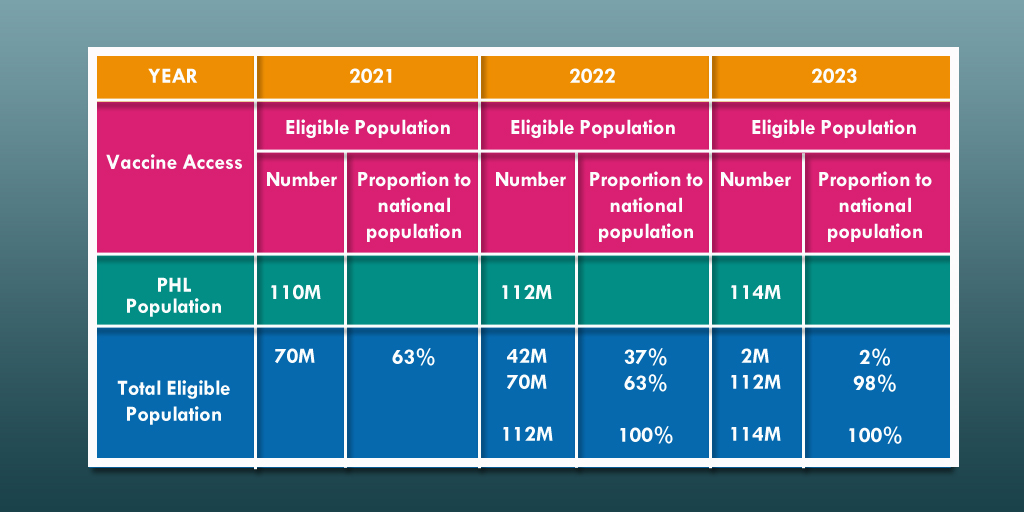 Source: DOH
Source: DOH
Achieving Herd Immunity
Though WHO emphasizes that “the proportion of the population that must be vaccinated against COVID-19 to begin inducing herd immunity is not known,” the Philippine government’s goal of vaccinating 70 million Filipinos this 2021 aims to achieve herd immunity. Because each vaccination requires two doses, 140 million vaccine doses need to be rolled out in a year.
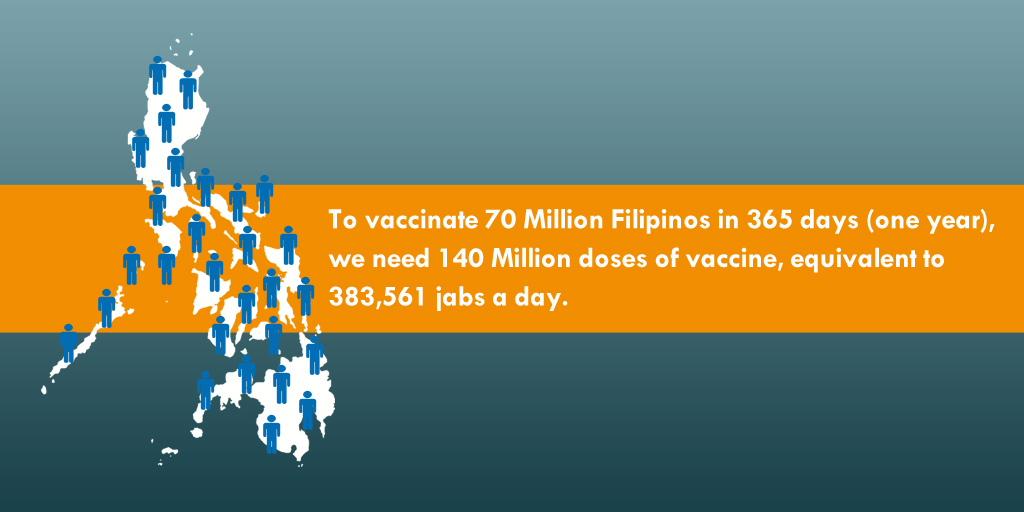
Based on such figures, the government needs to ramp up its vaccination drive to achieve herd immunity, and enable the country to recover both from the health and economic crises.
The country’s battle against the pandemic is still unfolding but one thing remains clear: until the crucial number of 70 million have not been vaccinated, Filipinos need to be on their toes as cases continue to surge.
Time is of the essence, but with majority having no means for vaccination yet, basic health and safety measures are still the strongest defense against this disease which continues to add to the global death toll of over 2 million.
In the Caribbean Sea, we find Jamaica, an island country popular among tourists. When the Spanish occupied it in the 16th century, they brought African slaves, which explains why majority of present-day Jamaicans are of African descent. Despite its small size, Jamaica’s global influence is considerable, birthing the Rastafari religion and reggae music—a music style that combines Jamaican folk music and American jazz, and rhythm and blues. The country’s capital is Kingston, which, like the Philippines, has a tropical climate and experiences frequent hurricanes (or in our case, typhoons) and earthquakes. In Kingston, we find Frances Alcaraz, a Filipino illustrator of over 25 books for children and adults published in various countries.
 Frances (right) with daughter Rita and husband Stephen off to a Jamaican beach
Frances (right) with daughter Rita and husband Stephen off to a Jamaican beach
Journey to Jamaica
Even before I met my husband Stephen, a Canadian diplomat, I’d already enjoyed traveling. But since we got married in 2012, I’ve gotten the chance to not only tour exotic places, but also live in them.
In our first three years as a married couple, we resided in Sudan in North-East Africa. Three years later, we packed our bags and lived in Athens in Greece, where I gave birth to our daughter Rita. In 2018, we flew to Jamaica to live in Kingston.
The first time my husband and I got here, we exchanged looks, thinking the same thing: Jamaica and the Philippines are nearly interchangeable. It’s a tropical country with lots of beaches. People walk around in casual clothes and flip-flops. The Jamaicans are big on Christianity, so they devote their Sundays to church and family. Even the mangoes remind me of home, their taste and appearance similar to ours. The only difference is that Jamaicans don’t eat green mangoes. The first time I mentioned it to them, they found it weird. Because Jamaica is close to the U.S. and Canada, locals often go abroad to work—just like overseas Filipinos.
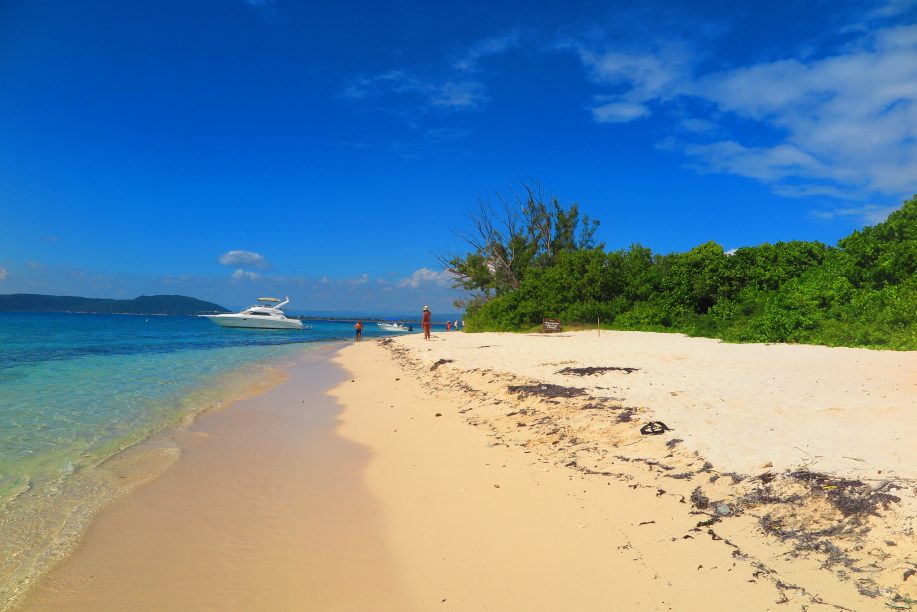 White-sand beach in Lime Cay off Port Royal, Jamaica
White-sand beach in Lime Cay off Port Royal, Jamaica
Living the Island Life
Because it’s a tourist destination, living in Jamaica is expensive, unlike in Manila. But similar to Manila, traffic can get really bad. Driving Rita to school usually takes 30 minutes, but with the killer combo of rain and rush hour, it could take us as long as two hours to get there.
But because it’s a small country, all the beaches and mountains are a driving distance from Kingston—about 3 hours at the most. You don’t need to take a plane or a boat to visit the more remote areas. The malls here are not huge, because people would rather visit the beach. The good thing here is that though Kingston is a concrete jungle, outside of it are pockets of paradise. The government makes it a point to not over-develop the tourist spots so they retain their natural charm.
You know when you watch movies with Jamaican characters who always say Ya mon? Well, it’s really the Jamaicans’ go-to expression! Everyone here says it, no matter their social status. It’s their equivalent of “okay” or “no problem”. From this alone, you can tell the Jamaicans are pretty chill. They have no boundaries. When you knock on their door, they welcome you right away. But what I had to adjust to is their directness. In general, we Pinoys don’t like to offend others, but Jamaicans like to speak their minds. At first, I found this behavior aggressive, but I’ve learned to be just as frank.
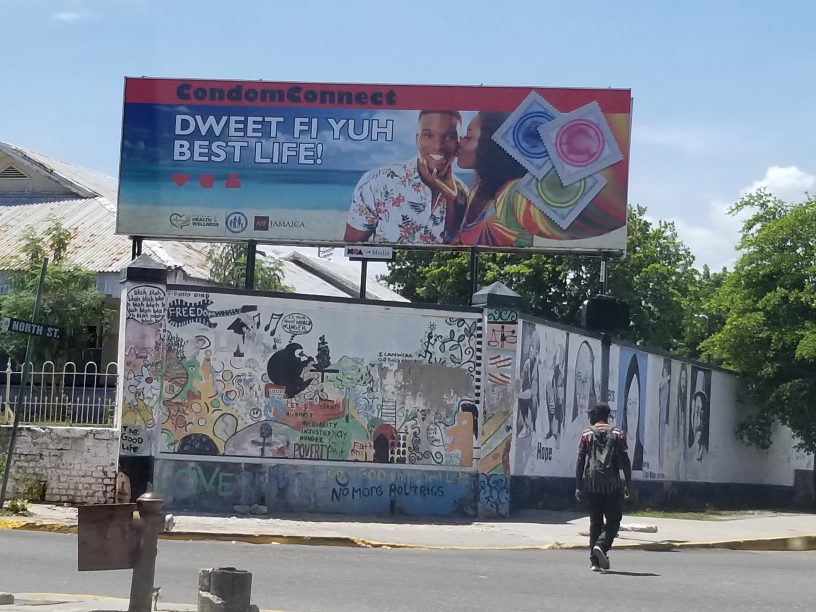 Colorful street art in Kingston
Colorful street art in Kingston
If you’re a foreigner in the Philippines, you can get by without having to learn the language because almost everyone speaks English. It’s the same way here. The first time I heard the local language Patois, I thought it was just heavily-accented English. But it’s a unique language on its own.
Despite their openness to foreigners, Jamaicans have strong national pride. They’re proud of their culture. You can see the Jamaican flag and its colors everywhere—on their beaches and even on their beach towels!
COVID-19 and Jamaica
During the first wave of the pandemic, we would get around 55 fresh cases a day. Then we closed our borders, and for some weeks, there were zero cases. A few months ago, we re-opened borders, and the cases began to climb again. The virus usually enters through Jamaicans returning from other countries. Because they’re very sociable like Pinoys, they meet up with relatives and hold big parties. So the government is much stricter now. Face masks are required, and there’s a curfew again.
 Port Royal was the famous headquarters of pirates back in the 17th century.
Port Royal was the famous headquarters of pirates back in the 17th century.
Balancing Art and Motherhood
Aside from being a freelance illustrator, I used to teach Writing and Illustrating for Children at the Ateneo de Manila University. Ideally, I can do my illustrating gigs from anywhere in the world. But Rita is only 4 years old, and for now, she takes priority. Even if Jamaicans often hire nannies, I’ve decided not to. Sometimes I get so exhausted that I’m tempted to hire a nanny. But since I can afford put aside my career, I’m Rita’s primary caregiver.
This year, Rita was supposed to spend half-days in school, leaving me to fix my art portfolio. But then the pandemic hit and she’s home all the time. It’s hard when she has no one play with. When she complains about being bored, I craft toys for her.
In 2016, I finished my passion project— illustrating and self-publishing a coloring book with fairy-tale characters. I began a second one, but it was put on hold because I had Rita. The last children’s book I illustrated was in 2017. Now I’m taking illustrating courses to refresh my skills.
 “Sirena” from Frances’s exhibit on Philippine mythical creatures
“Sirena” from Frances’s exhibit on Philippine mythical creatures
 Wizard of Oz characters in Frances’s coloring book on fairy tales
Wizard of Oz characters in Frances’s coloring book on fairy tales
In every country I live in, I make it a goal to hold an exhibit. In both Greece and Canada, I partnered with the Philippine Embassy to showcase my paintings of Philippine mythical creatures. This year, I was hoping to do a visual retelling of Florante and Laura, but because of the pandemic, I’d have to postpone it. I’m not really a big fan of painting, but I do it so my skills won’t get rusty.
Eventually, my dream is to illustrate for big publishing companies in New York and Canada. But in the meantime, I’m trying to get back into the groove of my art.
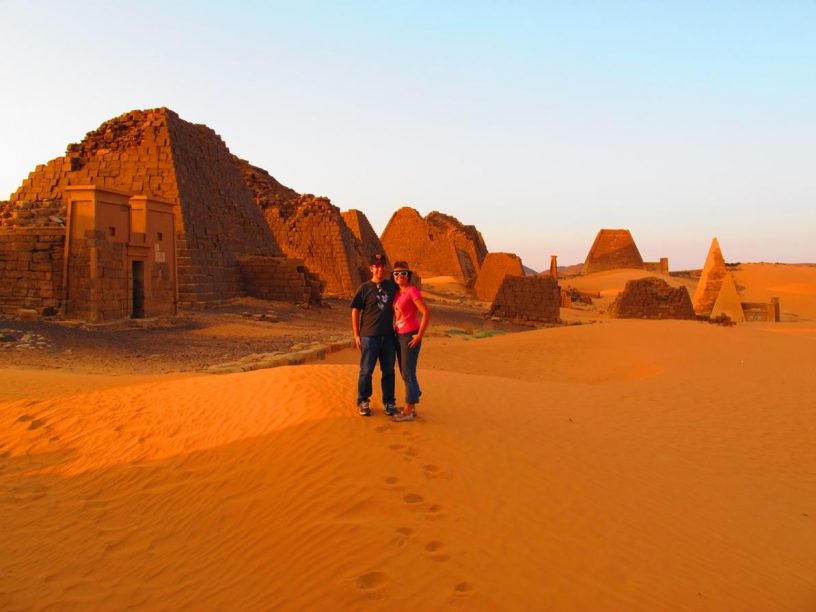 Frances and Stephen by the pyramids in Meroë, Sudan
Frances and Stephen by the pyramids in Meroë, Sudan
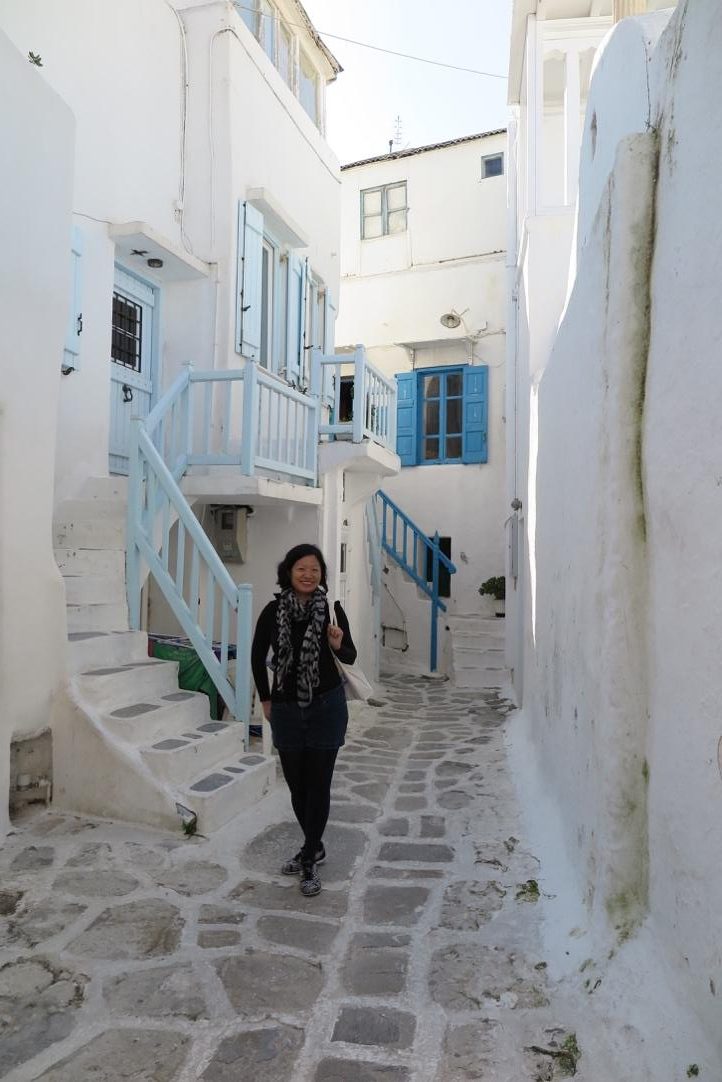 Frances exploring the alleys of Mykonos, Greece
Frances exploring the alleys of Mykonos, Greece
Living out of a Suitcase
Because of Stephen’s work, I’ve learned to adjust wherever I am. There’s no perfect place. Sometimes, I fall in love with a place; sometimes I don’t—and that’s totally fine. I’ve learned to manage expectations. In Sudan, I learned to cook. In Greece, I learned to be a mother. And now that I’m in Jamaica, I continue learning skills and more things about myself. Every now and then, we take breaks and travel to learn more about the country we temporarily call home.
It’s a hard life and I love it. It’s not for everyone; some people hate packing up and moving every 3 years. But I enjoy traveling and I get bored staying in one country for too long.
Don’t get me wrong—I do miss the Philippines. I miss my family, my friends, and even my hairdresser. I’m looking forward to going back, but I’m also excited to discover new countries and cultures with my family. I want to see more of Asia. I’d like to live in Australia. I’d like to explore even more of Jamaica before we once again pack our bags, leave, and start all over in a new country.
Click here to learn more about Frances Alcaraz’s work as an artist.
Last September 10, residents of California cities, particularly San Francisco, Oakland and Berkeley beheld an eerie sight of orange skies. Such was the result of wildfires raging in the US West Coast, their smoke and ash blotting out sunlight and creating the rust-colored haze.
According to the California Department of Forestry and Fire Protection, the wildfires began as early as January, and have already burned down more than 3 million acres in the state. Since the increased fire activity last August 15, there have been 24 deaths and over 4,000 damaged structures. But outside these figures, the wildfires have wreaked havoc in the atmosphere, putting areas under Air Quality Indexes of “very unhealthy” and even “hazardous”, forcing residents to stay indoors.
 Orange-tinged skies in the Bay Area in San Francisco last Sept. 10 at 10:30 a.m. (photo by Irma Cruz-Dimaisip)
Orange-tinged skies in the Bay Area in San Francisco last Sept. 10 at 10:30 a.m. (photo by Irma Cruz-Dimaisip)
The Pollution Problem
Even without the wildfires, ambient air pollution is a global problem, causing over 4 million deaths each year. According to the Centre for Research on Energy and Clean Air, pollutants are linked to severe respiratory and heart diseases, and lowers resistance against airborne viruses, making one vulnerable during the COVID-19 pandemic.
According to the World Health Organization (WHO), these human activities are the major sources of outdoor pollution:
- Fuel combustion from motor vehicles (e.g. cars and heavy duty vehicles)
- Heat and power generation (e.g. oil and coal power plants and boilers)
- Industrial facilities (e.g. manufacturing factories, mines, and oil refineries)
- Municipal and agricultural waste sites and waste incineration/burning
- Residential cooking, heating, and lighting with polluting fuels
- Poor urban planning, which leads to over-dependence on private vehicles
Combustion engines, fossil fuels and industrial activities produce Particulate Matter (PM), which contains sulphate, nitrates, ammonia, sodium chloride, black carbon, mineral dust and water. Most dangerous is PM2.5, which has a diameter of less than 2.5 micrometers. Because of its tiny size, PM2.5 is easily inhaled, allowing it to penetrate the lungs and blood stream, causing illnesses, which may lead to premature death.
WHO data further states that more than 80% of people living in urban areas that monitor air pollution are exposed to air quality levels that exceed WHO guideline limits. The most affected countries with the greatest toll are in the Western Pacific— and Southeast Asia, which includes the Philippines.
 Aerial view of the Pasig River (photo by Enrico Empainado/Greenpeace)
Aerial view of the Pasig River (photo by Enrico Empainado/Greenpeace)
Metro Manila’s Alarming Air Quality
Greenpeace Philippines reported a dramatic improvement in air quality during the enhanced community quarantine (ECQ) in Metro Manila from March 15 to May 15, 2020. With this measure to curtail the spread of COVID-19, most of the National Capital Region’s 2.5 million vehicles were kept off the road, resulting in PM2.5 levels dropping by an astounding 180%.
But this improvement was short-lived. Since the region shifted to general community quarantine (GCQ) last June 1, smog and pollution levels continue to climb, slowly reverting to the poor air quality experienced before ECQ.
Prior to the lockdown last February, groups such as Greenpeace, Clean Air Asia and the Center for Energy, Ecology and Development (CEED), Health Care without Harm, the Philippine Movement for Climate Justice (PMCJ), and the World Wildlife Fund for Nature (WWF) Philippines had called on the government to overhaul its monitoring and analysis of air pollution data to provide more accurate information. This was in response to the recent 2019 Air Visual report, which placed the Philippines in the 58th spot out of 98 countries. The groups argued that though the country’s ranking wasn’t high, data still showed that the country’s air quality was getting worse. In 2018, the country’s air pollution level of 17.6 micrograms per cubic meter was well beyond WHO’s safety limit of 10 micrograms per cubic meter.
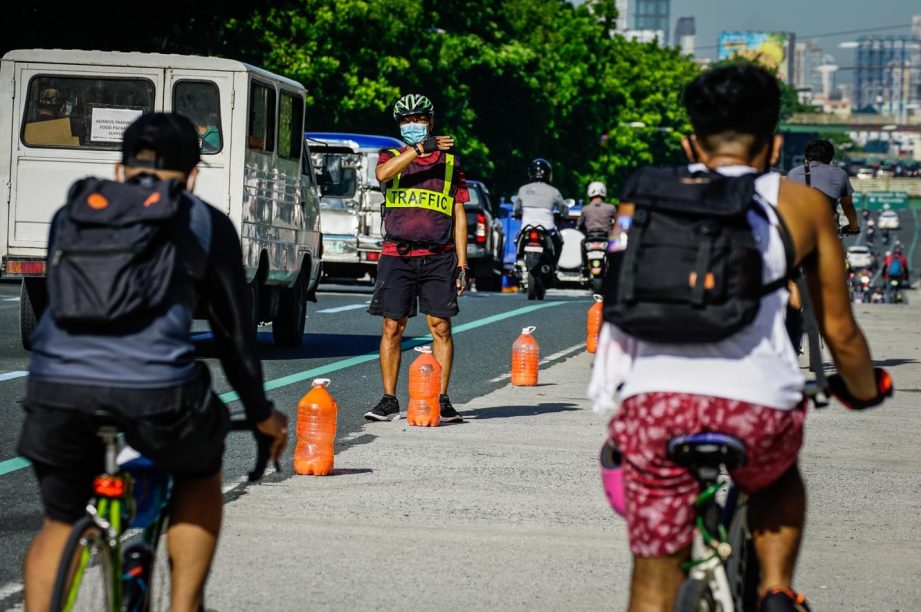 Bikers during ECQ (photo by Jire Carreon)
Bikers during ECQ (photo by Jire Carreon)
A Greenpeace Philippines report released in February, showed that toxic emissions could cost Filipinos as much as a 1.9% loss in Gross Domestic Product, as well as 27,000 premature deaths. For a clearer picture of the country’s air pollution, the groups urge the government to place monitoring stations near coal-driven power plants and areas of high traffic.
“The Philippine government should see the data as an impetus to overhaul air quality monitoring systems in the country, as well as to transition away from highly polluting facilities such as coal plants. Our safety standards for air pollution haven’t changed since 1999,” said Khevin Yu, campaigner of Greenpeace Philippines. “This situation has allowed industries and facilities to pollute the air we breathe with impunity.”
Meanwhile, Greenpeace campaigner Rhea Jane Pescador-Mallari believes that the ECQ showed Filipinos that healthy, clean air is possible in the metro. “Moving forward, if the government is willing to use the opportunities and lessons learned from the pandemic and amplify it through policies and infrastructure, active mobility and micro mobility, as well as invest in efficient and safe mass public transport, then a return to the massive pollution levels before COVID-19 can be avoided.”
Clean Air for All
The severity of recent global wildfires are fueled by climate change, which brings about soaring temperatures, drier conditions and pest outbreaks that weaken trees. According to WHO, air pollutants like black carbon and methane contribute to global warming and glacial melt. The Climate and Clean Air Coalition also states that air pollution threatens food and water supply by blocking sunlight, and affecting the movement and intensity of monsoons.
To secure the Filipinos’ health, Greenpeace Philippines advocates for the stricter implementation of the Clean Air Act, and the following measures:
- Maintaining flexible remote work arrangements or staggered work shifts, where possible
• People-centric urban design, where public spaces should be planned in parallel with the establishment of mobility programs
• Rebuilding trust in mass transit and supporting displaced transportation workers, possibly with LGU-centric green mobility services - Low-cost, active and carbon-neutral transport options that enable micro-mobility
• Tightening vehicle emission standards from Euro 2 to 4 to 6, and implementing accordingly
• Developing capabilities for real-time monitoring of dangerous pollutants in cities
• Strengthening industrial air pollution standards and wider adoption of renewable energy
Greenpeace believes that the efforts to solve air pollution are the same ones needed to mitigate the climate crisis. “As epicenters of growth, cities need to provide an environment that puts in high premium the health and wellness of both people and the planet. At the local level, addressing air pollution is a key aspect of making cities livable and sustainable. At the national level, it means addressing the climate crisis while helping build climate-resilient communities,” said Mallari.
Pregnancy is meant to be an exciting journey for expectant couples. But as the world grapples with the rising number of COVID-19 cases, this joyous experience is marred by uncertainty and worry.
According to the Centers for Disease Control and Prevention (CDC), pregnant people may be at an increased risk for severe illness from COVID-19 as compared to non-pregnant people. There may also be an increased risk of adverse pregnancy outcomes, such as preterm birth among women with COVID-19.
- Stay home and limit your interactions with other people.
- Strengthen your immune system by taking your prenatal vitamins, eating nutritious food, and getting enough exercise and at least eight hours of sleep.
Our country’s natural environment is in a dire state. According to the United States Agency for International Development (USAID), the Philippines is highly vulnerable to climate change with its increased weather events, and rising sea level and temperatures. A study conducted by the World Health Organization (WHO) in 2018 revealed that the Philippines ranks third in deaths due to air pollution. The country also ranks third as a source of plastic pollution in the oceans according to a 2015 report by Ocean Conservancy.
Pro-environment speeches always talk about how we need to save the environment for the next generation. But to solidify this advocacy, we need the next generation to fight alongside us in the name of environmental protection. And one effective way to do this is through children’s books that nourish young minds in engaging ways.

According to the 2017 Readership Survey by the National Book Development Board, picture books and storybooks for children are the second most-read book genre among respondents. Among children and even young adults, over 72% read the said genre.
Building on these statistics, Panahon TV celebrates Buwan ng Wika this August by featuring writers with a heart for Mother Nature. Their children’s books written in Filipino capture the next generation’s imagination, while instilling in them a love for the environment.
Writers slash Eco-Warriors
 Liwliwa Malabed
Liwliwa Malabed
With 16 children’s books published and 4 more waiting in the wing, Liwliwa Malabed has been writing for young readers for 18 years. Some of her books have been recognized by the Philippine Board on Books for Young People through the PBBY-Salanga Writers’ Prize. We shine the spotlight on her environmental book Luntian, Ang Bungang May Pakpak (Luntian, the Winged Seed Pod), illustrated by Aaron Asis and published by Lampara Books. The story talks about Luntian, a seed pod who dreams of becoming a sturdy forest tree like her mother. While chasing his dream, Luntian goes on an adventure, meeting a Northern Luzon giant cloud rat and a Rafflesia, the world’s largest flower.

How did the concept for the book come about?
Luntian was written after a visit to the Makiling Center for Mountain Ecosystems (MCME) in Los Baños, Laguna. There, I saw towering native trees like the Red Lauan. Our guide told us about indigenous species that depend on these trees to survive. Somehow, the idea that one tree can support all these creatures stuck and I went back to Manila with the imprint of the lauan tree in my mind.
How did you craft the story?
First, I researched on dipterocarps. I learned about how their seeds have wing-like parts so they can ride the wind and reach far. I also looked up the animals and plants that live on these trees. I personified my characters because I needed the seed pod to come alive, to have an active role its story. It is still a seed, yes— but with an impatient desire to become a giant.

What do you think are your book’s strongest points?
I made a conscious decision to write it in Filipino and I am glad I did. A story resonates more with children when told in a language they can easily understand. I am also happy with the story within the story part of the book, that Luntian wants to grow into a giant tree so she can be a home to forest creatures because of a tale told by Lolo Ninok, a Philippine scops owl. The illustrations by Aaron Asis are wonderful! The artist’s work is the puzzle piece that completes the narrative.
What do you hope children will learn after reading your book?
I am hoping that children will be more aware of how magnificent and valuable trees are, that planting native trees is beneficial to the environment because they are more resilient against strong winds and flooding brought about by typhoons. Also, endemic species prefer to live in native trees.
 Jomike Tejido
Jomike Tejido
Jomike Tejido is both a writer and illustrator with over 50 children’s books under his belt. In 2010, he won two National Book Awards for writing and illustrating Tagu-Taguan, and for illustrating Lub-Dub, Lub-Dub about pioneering pediatrician Fe del Mundo. Also an architect, Jomike has been writing children’s picture books since 2001. One of them is the Anvil-published endangered species series, which features lovable stories about the pawikan (marine turtle), dugong, Philippine eagle, and tamaraw (Mindoro dwarf buffalo) among others.
 5 of 7 books in Jomike’s endangered species series
5 of 7 books in Jomike’s endangered species series
How did the concept for the endangered species series come about?
The series was commissioned by Anvil Books in 2007 and it was my first experience in having a commissioned set of three stories. Then the series picked up and more titles sprang. They must have commissioned me for it due to my long-running daily comic strip that dealt with the lighter side of environmental issues. Mikrokosmos in the Philippine Daily Inquirer ran from 2000 to 2007.
How did you craft the stories?
I took into consideration some pointers I learned from the writers’ workshop I attended, wherein a child psychologist talked about a child’s psychological needs. From there, I made my stories more mundane and specific. Pao Tamaraw was inconsiderate and playful, while Gilas Agila was boastful and had a superiority complex. All these traits are flaws relatable to children, and personified by animals in their habitat. As children can sometimes act like “wild animals,” I could easily relate animals to kids. I worked with Haribon Foundation, and I had a pack of endangered animal flashcards I used as my main list. Then I worked with credible websites to fill in other factual details.

What do you think are the strongest points of this series?
The strongest points are my low word count (thus short storyline), relatable characters and whimsical digital art. I made it a point that the science part wasn’t didactic or rammed into the readers’ minds.
What do you hope children will learn after reading these books?
I hope that children can learn to love animals, especially those endemic to our country, and not feel that just because they are local, they are uncool. I’d like young Filipinos to be proud that these creatures come from their land. I want them to know where these animals live and what they eat, just like how kids are familiar with foreign creatures from TV or books.
 Augie Rivera
Augie Rivera
Writing for the classic Filipino children’s show Batibot propelled Augie Rivera to be a children’s book writer. His books have received recognition from award-giving bodies, including the prestigious Carlos Palanca Memorial Awards for Literature. Recently, he was awarded with the 2020 Gawad Pambansang Alagad ni Balagtas for Children’s Literature in Filipino. Last year, Augie’s 19th book, Bayan ng Basura, illustrated by Jill Arteche, was published by Adarna House and Greenpeace Southeast Asia – Philippines. The protagonist is a pawikan who, after a storm, ends up in the deep end of the ocean littered with trash and ailing fellow sea creatures.

How did you come up with the story’s concept?
The book was commissioned by Greenpeace because they wanted to tackle the issues of single-use plastics and ocean pollution. I based the story on real-life events, such as the marine turtle that had a plastic straw shoved up its nose in Costa Rica in 2015. I also read up on the dead whale in Compostela Valley which had 40 kilograms of plastic in its stomach. Then I saw a footage of a British diver in Bali who showed the incredible amount of garbage floating on the sea. These bits of news fueled my imagination, which was why my story had a post-apocalyptic feel to it, wherein there was more garbage than sea creatures.
What do you think are your book’s strongest points?
I really like the book illustrations by Jill Arteche. The first time I saw them, the style reminded me of Maurice Sendak’s work. When I met Jill, I found out that Sendak is one of her major influences. When the pawikan was surround by trash, the illustrations were dim. They brightened when the trash disappeared.

What do you hope kids will learn from story?
I want them to be aware that they can do something to solve a big problem such as ocean pollution. They can do their part in their own little ways because that’s how big problems start—from little things. I want them to be mindful of their actions because humans are not the only living things here on earth.

Practicing What They Preach
These writers don’t only write about caring for the environment; in their own homes, they also practice eco-friendliness. Liwliwa, for instance, was brought up by a grandmother who taught her how to reuse and recycle. “At home, we try to be mindful of our carbon footprint, conserving water and energy, and refusing single-use plastic.”
Jomike reuses product packaging, and passes on environmental values to his children. “I teach my kids to save water and energy by turning off faucets and appliances when not in use. I let them watch nature documentaries to expand their world view, and see animals wider than the scope of domestic pets,” he shares.
Ever since Augie moved to Marikina a few years ago, he’s been more conscious of waste segregation. “Once, I accidentally mixed vegetable peel with non-recyclable waste, and I had to go to the City Environment Management Office to either pay the fine of P2,000 or do community work. I never made the mistake again.” When he goes out, Augie brings his own eco bag, straw and utensils. “I agreed to write Bayan ng Basura because I really support environmental advocacies.”
 Linaaw, Liwliwa’s daughter, reads her mother’s book
Linaaw, Liwliwa’s daughter, reads her mother’s book
Telling Mother Nature’s Stories
All these children’s book writers agree—it’s vital to write environmental stories for children.
“It’s important to imbue the love for animals and care for the environment at a young age,” Jomike shares. “Stories like mine aim to foster the love for these creatures by letting kids feel that these characters are like their friends (or themselves), who have flaws like any normal person and can be taught to become better.”
Liwliwa thinks that these stories are more important now during the pandemic. “Nowadays, children are always indoors, and stories connect them with the outside world,” she says. “Stories about the environment make children realize how nature makes it possible for us to live our lives and how children can participate in protecting our planet.”
Augie believes that stories about the environment gives hope to the next generation. “As grownups, we didn’t do our part in saving our planet. So we should raise our children’s awareness on the issues, and encourage them to do their part and hope for a better world to live in.”
For four years now, my duties as head writer for Panahon TV includes checking the team’s individual book reports—a monthly requirement Executive Producer Donna Lina cooked up to upskill employees. “As we are a content creation group, there’s a need to ensure we have a steady supply of ideas,” she shares. “One of the best ways of sharpening our comprehension and critical skills is through reading.”
But aside from reading’s popular benefits, such as enriching vocabulary, and improving focus and analytical skills, studies show that it also sharpens memory. A 2013 study by the Rush University Medical Center in Chicago revealed that engaging regularly in mentally-stimulating activities, such as reading, keeps dementia at bay. But another study published in the Social Science & Medicine journal in 2016 revealed an even more astonishing discovery—by observing the reading patterns of almost 4,000 people who were 50 years old and above, book readers were found to live almost two years longer than non-readers.
What accounts for this supposed longevity among bookworms? Perhaps the answer lies in even more studies that show how reading helps manage stress and depression.
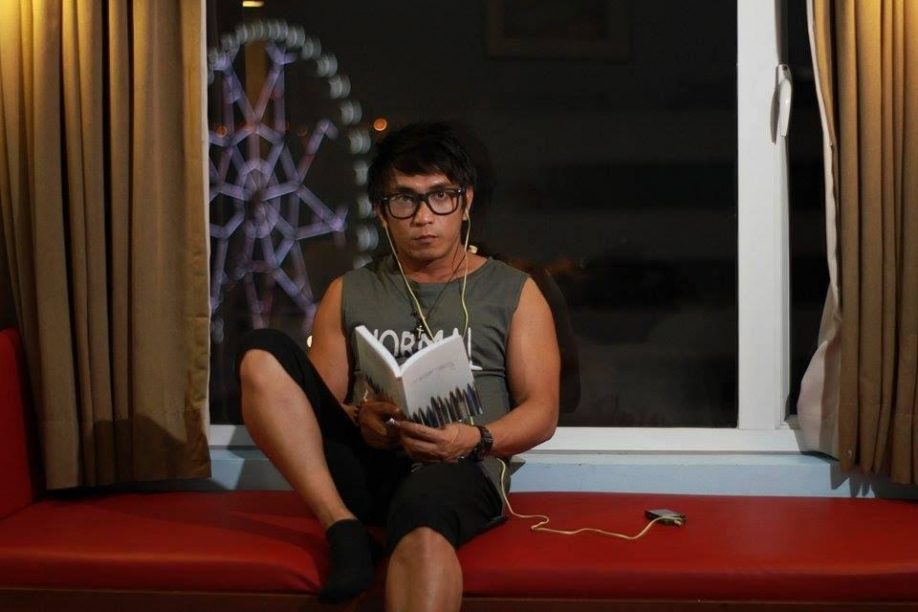 PM Caisip, live producer and video editor
PM Caisip, live producer and video editor
 Hollie Delles, administrative assistant
Hollie Delles, administrative assistant
 Trisha Garin, oncam reporter and segment producer
Trisha Garin, oncam reporter and segment producer
Each month, employees are required to submit a book report of one or two pages on a book they’ve recently read. Books, including graphic novels, have to be at least 100 pages, and can be in Filipino or English. Those who fail to submit are penalized, while I pick the best book report—the author of which receives a cash prize.
But beyond the reward-and-sanction scheme, Lina wants her employees to read because they enjoy it. “If you get to love reading and enjoy it, the possibilities are limitless. It can take you to places you have never imagined, and helps you understand the world better.” She adds, “From a skills standpoint, you can learn without having to spend so much. Access is easier now with the e-books—or you can simply borrow books from friends and neighbors.”
PM Caisip, who’s never missed a submission in four years, shares how he’s always loved reading—but only books in Filipino. “At first, it was a challenge for me to read books written in English, and then write a report about them.” But through practice, PM has gained more confidence. “When I read, it’s like I’m watching a movie, which is one of my favorite things to do. I learn a lot, especially if the book deals with a character or culture I’m not familiar with.”
Hollie Deles, who also regularly submits, shares how reading is a passion that stems from her childhood. “When I was a child, I loved visiting our school library and reading. Books challenge my perspective in life. When I read a story that has an unsatisfactory ending, I imagine my own ending.”
But Trisha Garin’s story is different. She admits that at first, reading was a chore. “I didn’t regularly participate in our monthly book reports because it was hard for me to finish a book, especially when I didn’t like the character or where the story was going.” But her recent win in the exercise made her realize that her problem didn’t lay in reading itself, but in the books she read. “Before, I sent an entry about a fiction book that I read, and I wasn’t happy with my writing. Then my boyfriend introduced me to a non-fiction book entitled “The Miracle Morning”, which encouraged me to keep a gratitude journal. It helped clear my mind, and more importantly, it made me want to read more books that will help me mentally and spiritually. After that, I didn’t have to pressure myself anymore to submit book reports. I now read because it keeps my soul alive. For people who experience anxiety, reading is a big help.”
Reading and loving it
Years of reading the team’s book reports have allowed me to observe how the regular submitters’ written skills have evolved and vastly improved. Their sentences are more masterfully crafted with a wider vocabulary. In choosing a winner, I keep in mind that a good book report displays good grammar. But sometimes, I allow technical skills to take a backseat to passionate writing.
 Hollie’s winning book report was on The Butterfly Lion by Michael Morpurgo
Hollie’s winning book report was on The Butterfly Lion by Michael Morpurgo
It is such passion that fuels Hollie to submit month after month. “It’s not about winning the cash prize; reading is a reward in itself. It relaxes me, and teaches me life lessons. When I encounter an unfamiliar word or phrase while reading, I immediately ‘Google’ it.”
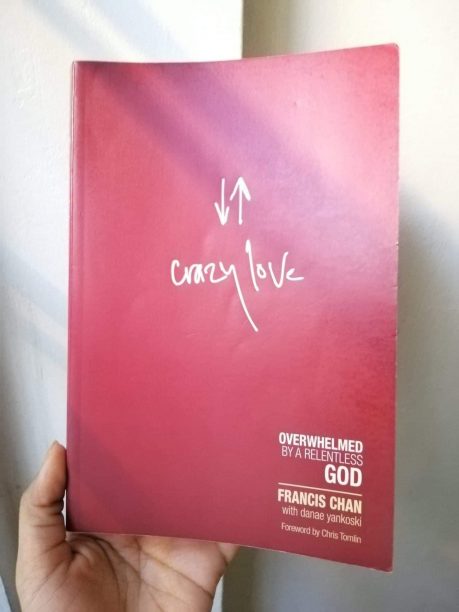 Trisha’s current read
Trisha’s current read
For Trisha, reading helps her to comprehend and condense news articles—a key part of her job as a reporter. “It also helps me to be more fluent in conversation—and most importantly, reading lifts my mood.”
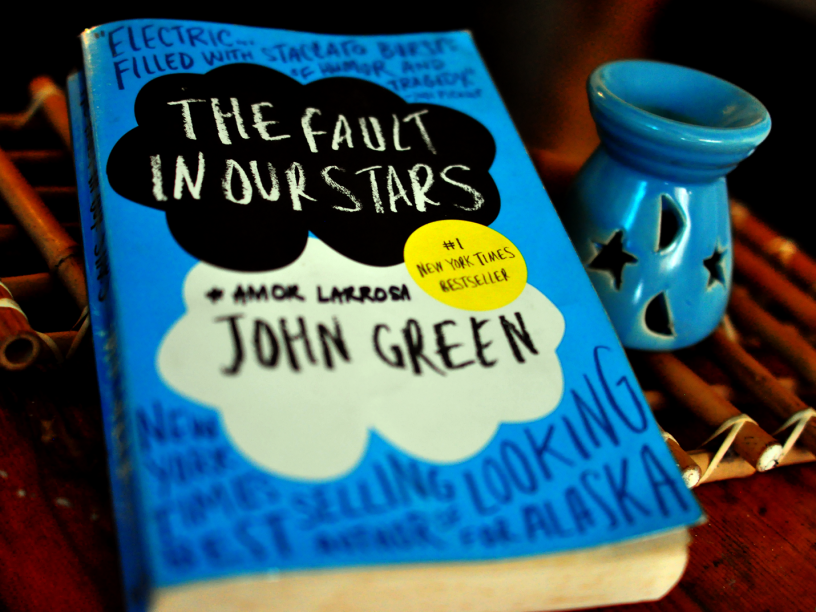
One of PM’s winning book reports was on The Fault in Our Stars by John Green
PM sees reading as an essential part of his life. “When you’ve done it for a long time, it’s in your system. Reading for me is like my daily intake of vitamin C.”
Practical application
Now that we’re in the middle of a pandemic, Lina believes the reading is more relevant than ever. “There’s so much literature out there. If you don’t have reading skills, you miss out on finding solutions to problems.”
PM agrees. “Because of reading, I’ve become more aware of situations around me. It improves my focus, creativity and research skills.” Hollie shares that reading has improved her life perspective. This is also what Trisha has learned from her favorite non-fiction books. “We need to be able to accept life as it is, and to live it to the fullest.
It has often been said that when a chapter closes, a new one begins. Whatever chapter they’re in, Lina hopes that all her team members learn the long-term value of reading. “I hope they appreciate the amount of effort that goes into encouraging people to read and eventually savoring it.” She ends, “I’ve always believed that you need to read to save your life.”
Donna Lina’s Top Ten Books
- The old Archie Comics
- The Checklist Manifesto by Atul Gawande
- The Last Lecture by Randy Pausch
- Anne of Green Gables by L.M. Montgomery
- Noli Me Tangere by Jose Rizal
- El Filibusterismo by Jose Rizal
- Quiet: The Power of Introverts in a World that Won’t Stop Talking by Susan Cain
- The Bible
- The Little Prince by Antoine de Saint-Exupery
- The Tipping Point by Malcolm Gladwell
